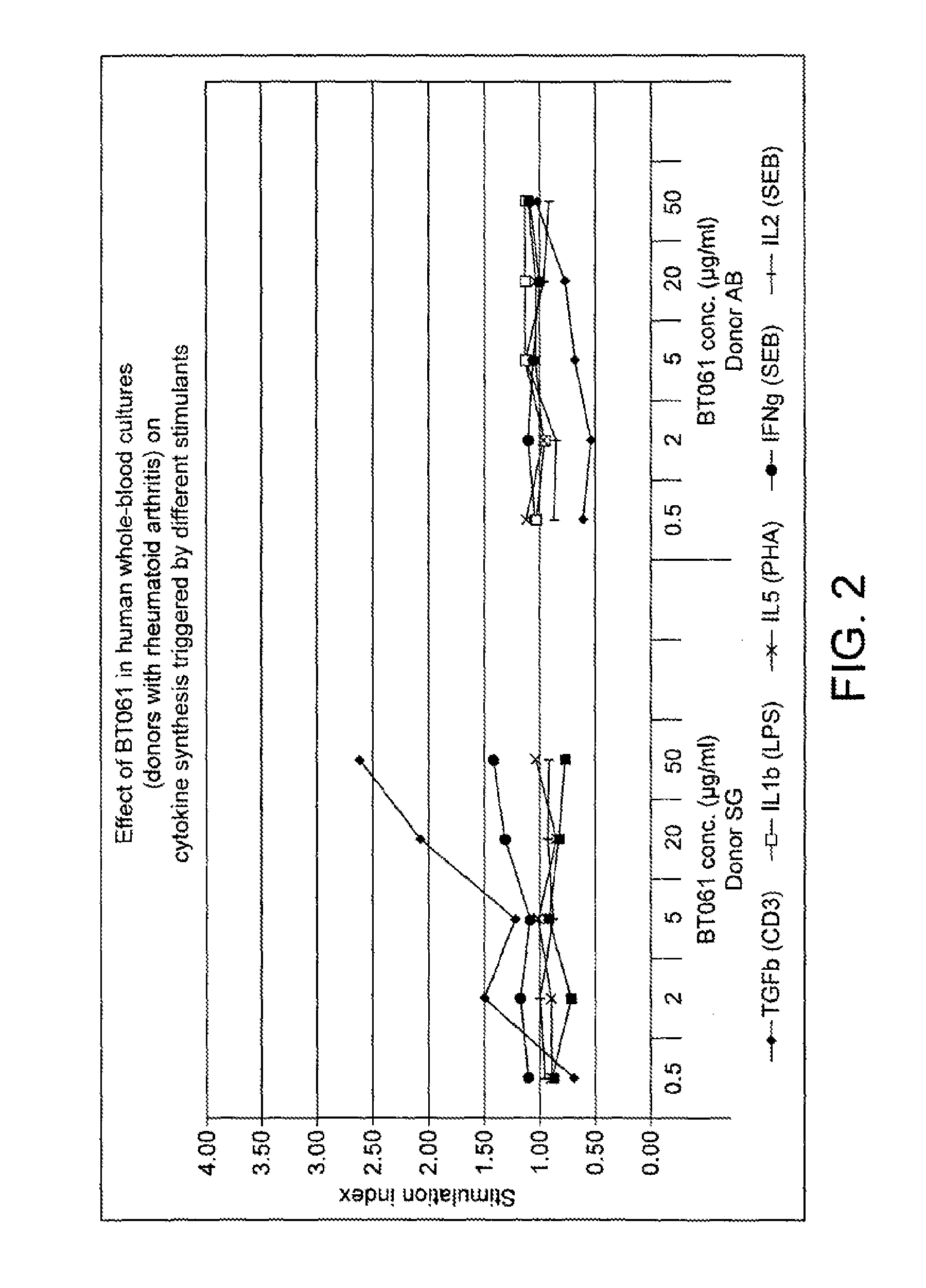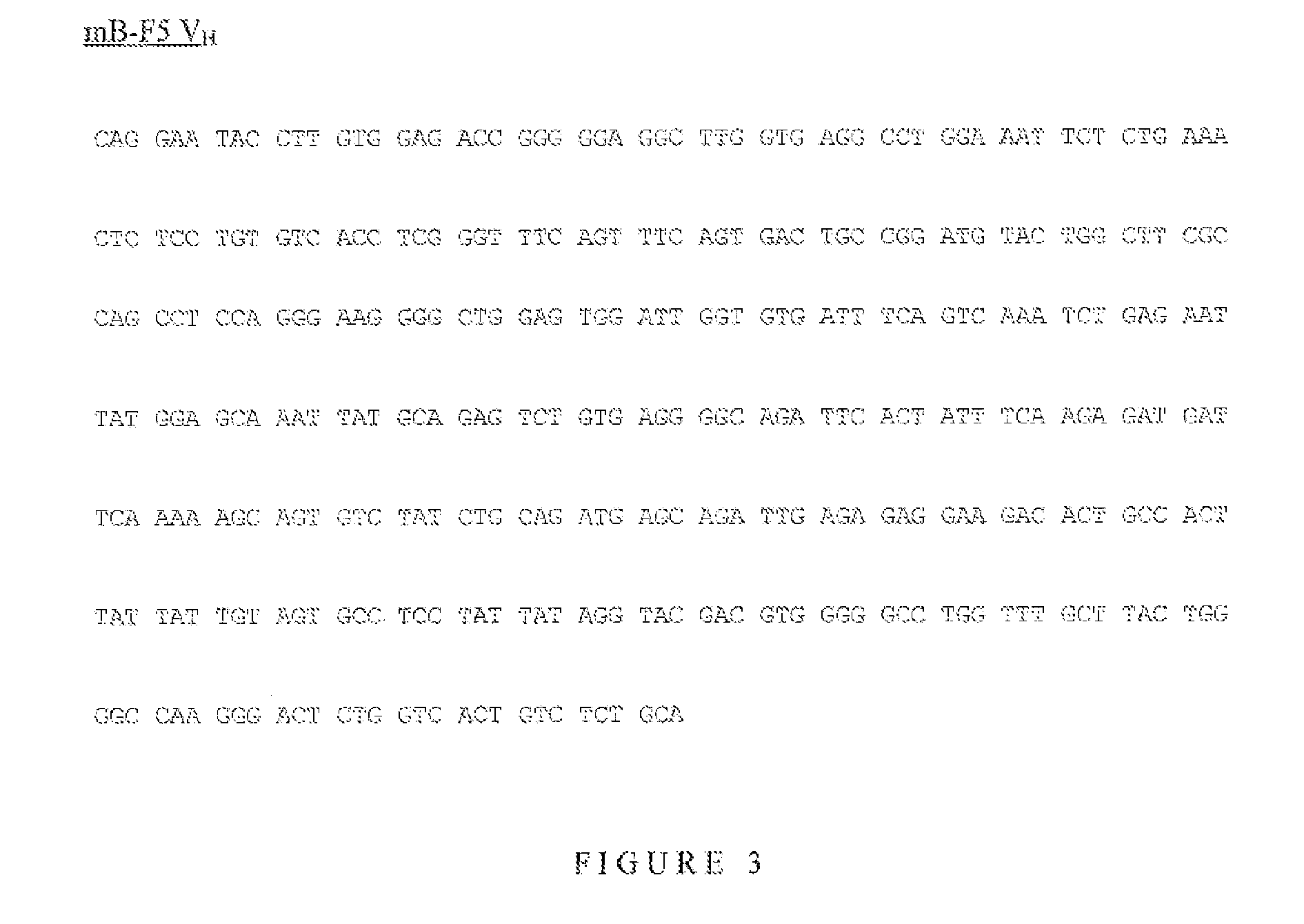Agent for treating disease
a technology for a drug and a treatment method, applied in the field of autoimmune diseases, can solve the problems of multiple side effects, not only harmful functions, and several risks, and achieve the effect of effective treatment and convenient administration
- Summary
- Abstract
- Description
- Claims
- Application Information
AI Technical Summary
Benefits of technology
Problems solved by technology
Method used
Image
Examples
example 1
Investigation of the Immuno-Modulating Capacities of BT061 Regarding T Cell Proliferation
[0165]Method
[0166]Whole-blood cultures were performed with freshly drawn peripheral blood. Briefly, using 19G needles blood from three healthy volunteers was collected into heparinised syringes. The blood was seeded into 96-well culture plates not later than 60 min after donation.
[0167]The antibody used in the invention (BT061, lot 40588, or lot 70A0013B) was added to the cultures before stimulation of the leukocytes at 5 different concentrations (see “Test substances” below) The cells were allowed to interact with the antibody for 90 min at 37° C., 5% CO2 in humidified atmosphere, then four different stimulants were added to separate cultures:
[0168](a) anti-CD3 antibodies (R&D Systems; 50 ng / ml)
[0169](b) phytohaemagglutinin (PHA, Biochrom KG; 3 pa / ml) together with anti-CD28 antibodies (Becton-Dickinson; 1 μg / ml);
[0170](c) lipopolysaccharide (LPS, subtype 055:B15 from Sigma Aldrich; 1 μg / ml);
[0...
example 2
Testing of BT061 for its Influence on Cultivated Human PBMCs Primed for an Anti-Tetanus Toxoid Response and Cytokine Assay
[0183]Method
[0184]Proliferation Assay
[0185]Freshly isolated PBMC were cultivated in 96 well flat bottom microtiter-plates in a volume of 200 μl / well (4×105 cells / well). The test-item (Anti CD4 mAb BT061) was used in the concentrations of 20 μg / ml, 4 μg / ml and 0.8 μg / ml (additionally 40 μg / ml within the pre test); Tetanus-Toxoid was used in concentrations of 25 μg / ml, 5 μg / ml and 1 μg / ml. For the negative control cell culture medium was taken. All cultures were set up as triplicates.
[0186]For the ConA-stimulation a concentration of 2.5 μg / ml and a volume of 200 μDwell was used. The PBMC was adjusted to a density of 1×106 / ml and dispensed in a volume of 100 μl per well.
[0187]At the end of the culture period, cell proliferation was detected by adding 0.4 μCi of 3H-thymidine per well for sixteen hours. At the end of the culture period the cells were detached from the...
example 3
A Flow Cytometric Test for BT061 (Anti-CD4 mAb) Induced ADCC (Antibody-Dependent, Cell-Mediated Cytotoxicity)
[0204]HuT 78 target cells were labelled with BT061 (hB-F5) and incubated with PBMC cells as effectors. Dead cells could be detected due to the uptake of the DNA dye propidium iodine after an incubation time of 30 minutes. Results are shown in Table 5.
TABLE 5Tecelac / ATG)Negative(positive control)control meanSpecific cellConcentrationmean fluorescencefluorescencedeath (ADCC)[μg / ml]intensityintensity[%]7531.7811.9619.8237.0525.0912.7012.3918.7522.2510.5911.669.3814.9510.634.32NegativehB-F5 meancontrol meanSpecific cellConcentrationfluorescencefluorescencedeath (ADCC)[μg / ml]intensityintensity[%]70.8510.9613.41−2.4535.4311.0614.05−2.9917.7111.6812.16−0.488.8610.5410.230.31
[0205]The data in the table demonstrate that there was no induction of ADCC by BT061 (hB-F5) even at high concentrations
PUM
| Property | Measurement | Unit |
|---|---|---|
| concentration | aaaaa | aaaaa |
| body weight | aaaaa | aaaaa |
| body weight | aaaaa | aaaaa |
Abstract
Description
Claims
Application Information
 Login to View More
Login to View More - R&D
- Intellectual Property
- Life Sciences
- Materials
- Tech Scout
- Unparalleled Data Quality
- Higher Quality Content
- 60% Fewer Hallucinations
Browse by: Latest US Patents, China's latest patents, Technical Efficacy Thesaurus, Application Domain, Technology Topic, Popular Technical Reports.
© 2025 PatSnap. All rights reserved.Legal|Privacy policy|Modern Slavery Act Transparency Statement|Sitemap|About US| Contact US: help@patsnap.com



